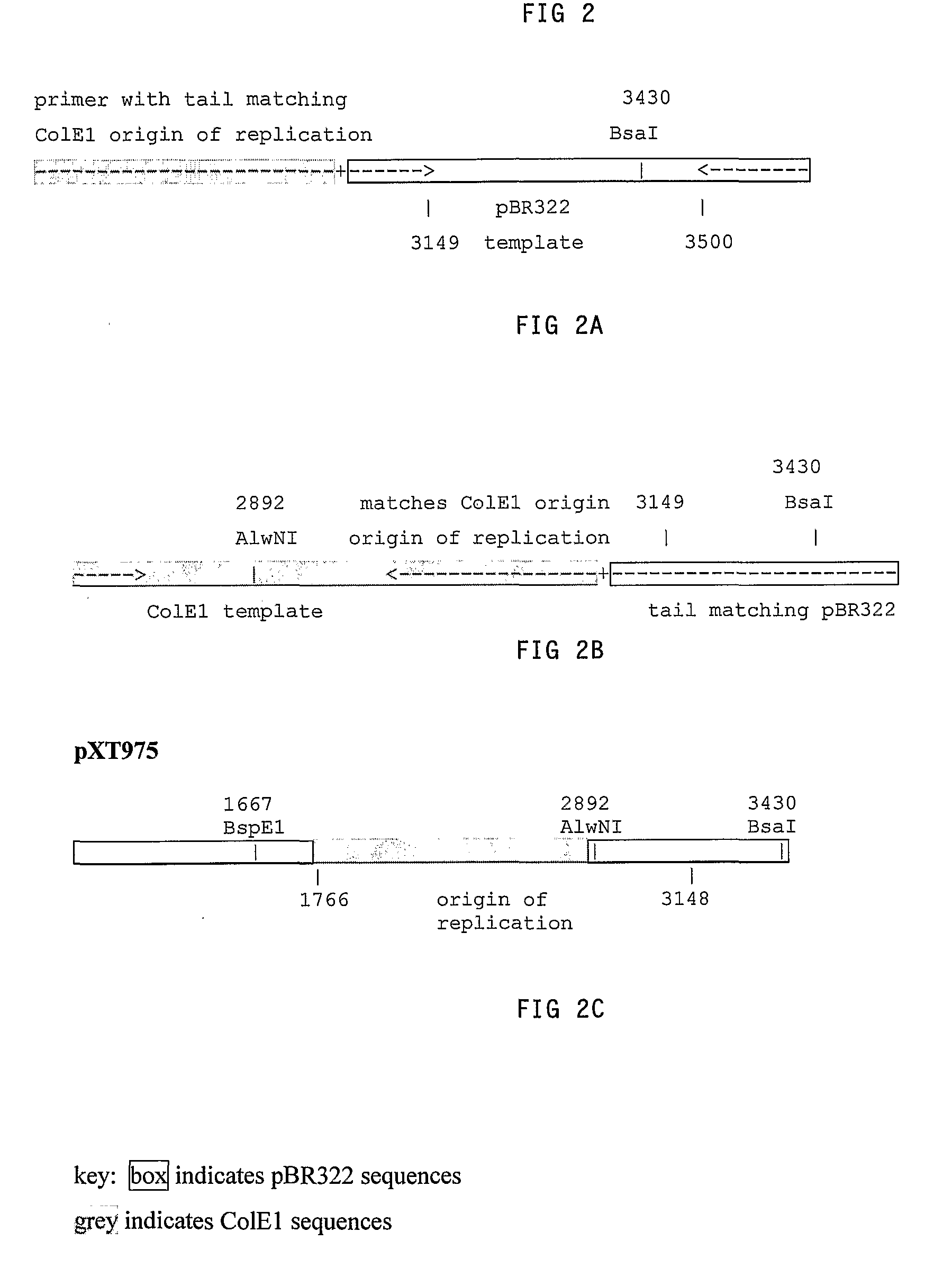Hybrid portable origin of replication plasmids
a technology of replication plasmids and portable origins, which is applied in the field of modified portable origins of replication, can solve the problems of difficult if not impossible cloning of the gene of interest, low copy number range, and inability to simply “cut and paste"
- Summary
- Abstract
- Description
- Claims
- Application Information
AI Technical Summary
Benefits of technology
Problems solved by technology
Method used
Image
Examples
example 1
Construction of pXT975
[0086]Primers were used to amplify by PCR the region on pBR322 from about coordinate 3149 within the origin of replication region to about coordinate 3500, past the BsaI site at coordinate 3430, as shown in FIG. 2. The nucleotide sequence of pBR322 is described in SEQ ID NO: 1. The nucleotide sequence given here is different from that found in Genbank, as more recent nucleotide sequencing of the plasmid pBR322 by the inventors has shown differences with the Genbank nucleotide sequence; the nucleotide sequence given here is believed by the inventors to be the correct nucleotide sequence of pBR322.
[0087]The following primers were utilized for these initial amplification steps:
SEQ ID NO:2:5′-GCTCGGCCCTTCCGGCTGGC-3′SEQ ID NO:3:5′-TTACGCGCAGAAAAAAAGGATCTCAAGAAGATCCTTTAATCTTTTCTACGGGGTCTGACGCTCAGTGGAACGAAAACTCACGTTAAGGGATTTTGGTC-3′
The primer for the region at coordinate 3149 (SEQ ID NO:3) included a long tail matching the corresponding region of the ColE1 origin of r...
example 2
Construction of pXT976
[0091]Primers were used to amplify by PCR the region on pBR322 from just before the BspEI site at coordinate 1667 to coordinate 1766 as shown in FIG. 3. The following primers were utilized for these initial amplification steps:
(SEQ ID NO:85′-GCGACCTGAGCAACAACATGAATGG-3′)(SEQ ID NO:95′-TTACTTGAACGCTGTGAGGGTAAACAACTGGCGGTATGGATGCGGCGGGACCAGAGAAAAATCACTCAGGGTCAATGCCAGCGCTTCGTTAATACAGATG-3′)
The primer for the region at coordinate 1765 (SEQ ID NO:9) included a long tail matching the corresponding region of the ColE1 origin of replication.
[0092]The resulting 236 base pair PCR fragment was used as the source of a 236 base pair primer (SEQ ID NO:10),
1GCGACCTGAGCAACAACATGAATGGTCTTCGGTTTCCGTGTTTCGTAAAG 51TCTGGAAACGCGGAAGTCAGCGCCCTGCACCATTATGTTCCGGATCTGCA101TCGCAGGATGCTGCTGGCTACCCTGTGGAACACCTACATCTGTATTAACG151AAGCGCTGGCATTGACCCTGAGTGATTTTTCTCTGGTCCCGCCGCATCCA201TACCGCCAGTTGTTTACCCTCACAGCGTTCAAGTAA
along with a second, regular primer matching the ColE1 origin of replicati...
example 3
Construction of pXT977
[0094]The final two PCR fragments as described above for the construction of pXT975 and pXT976, were cut with AlwNI, ligated together, and then amplified with PCR primers matching the tail regions (SEQ ID NO:2, and SEQ ID NO:8, shown above) outside the BspEI and BsaI sites.
[0095]The resulting PCR fragment was digested with BspEI and BsaI and inserted into pBR322. This yielded plasmid pXT977, which has the pBR322 origin of replication region from coordinates 1766 to 3148 replaced with the corresponding region from the ColE1 origin of replication. The nucleotide sequence of pXT977 is described as SEQ ID NO: 13.
PUM
| Property | Measurement | Unit |
|---|---|---|
| lag time | aaaaa | aaaaa |
| antibiotic resistance | aaaaa | aaaaa |
| length | aaaaa | aaaaa |
Abstract
Description
Claims
Application Information
 Login to View More
Login to View More - R&D
- Intellectual Property
- Life Sciences
- Materials
- Tech Scout
- Unparalleled Data Quality
- Higher Quality Content
- 60% Fewer Hallucinations
Browse by: Latest US Patents, China's latest patents, Technical Efficacy Thesaurus, Application Domain, Technology Topic, Popular Technical Reports.
© 2025 PatSnap. All rights reserved.Legal|Privacy policy|Modern Slavery Act Transparency Statement|Sitemap|About US| Contact US: help@patsnap.com



